Simin Fan
Apertus: Democratizing Open and Compliant LLMs for Global Language Environments
Sep 17, 2025Abstract:We present Apertus, a fully open suite of large language models (LLMs) designed to address two systemic shortcomings in today's open model ecosystem: data compliance and multilingual representation. Unlike many prior models that release weights without reproducible data pipelines or regard for content-owner rights, Apertus models are pretrained exclusively on openly available data, retroactively respecting robots.txt exclusions and filtering for non-permissive, toxic, and personally identifiable content. To mitigate risks of memorization, we adopt the Goldfish objective during pretraining, strongly suppressing verbatim recall of data while retaining downstream task performance. The Apertus models also expand multilingual coverage, training on 15T tokens from over 1800 languages, with ~40% of pretraining data allocated to non-English content. Released at 8B and 70B scales, Apertus approaches state-of-the-art results among fully open models on multilingual benchmarks, rivalling or surpassing open-weight counterparts. Beyond model weights, we release all scientific artifacts from our development cycle with a permissive license, including data preparation scripts, checkpoints, evaluation suites, and training code, enabling transparent audit and extension.
GRAPE: Optimize Data Mixture for Group Robust Multi-target Adaptive Pretraining
May 26, 2025



Abstract:The performance of large language models (LLMs) across diverse downstream applications is fundamentally governed by the quality and composition of their pretraining corpora. Existing domain reweighting algorithms primarily optimize data mixtures for a single target task, thereby resulting in models that overfit to specialized objectives while exhibiting substantial performance degradation on other benchmarks. This paper introduces Group Robust Multi-target Adaptive PrEtraining (GRAPE), a novel multi-source-multi-target domain reweighting framework designed to calibrate pretraining data mixtures for robust performance across multiple target tasks simultaneously. GRAPE dynamically adjusts sampling weights across source domains (domain weights) while concurrently modulating task weights that quantify the relative importance of each individual target task. This adaptive process prioritizes tasks based on their learning difficulty throughout training. We formulate this interleaved reweighting mechanism as a minimax optimization problem: The inner maximization adjusts task weights leveraging group distributed-robust-optimization (DRO), where those tasks demonstrating the least improvement under the current data mixture are prioritized with higher weights; The outer minimization then optimizes domain weights to maximize loss reduction on the prioritized tasks. Experiments on ClimbLab and SlimPajama datasets demonstrate that GRAPE consistently outperforms baseline methods in terms of reasoning performance across 6 benchmarks. Furthermore, when applied to multilingual targets, GRAPE effectively identifies optimal training mixtures from mainstream languages, achieving superior language modeling capabilities across 8 low-resource target languages.
NeuralGrok: Accelerate Grokking by Neural Gradient Transformation
Apr 24, 2025Abstract:Grokking is proposed and widely studied as an intricate phenomenon in which generalization is achieved after a long-lasting period of overfitting. In this work, we propose NeuralGrok, a novel gradient-based approach that learns an optimal gradient transformation to accelerate the generalization of transformers in arithmetic tasks. Specifically, NeuralGrok trains an auxiliary module (e.g., an MLP block) in conjunction with the base model. This module dynamically modulates the influence of individual gradient components based on their contribution to generalization, guided by a bilevel optimization algorithm. Our extensive experiments demonstrate that NeuralGrok significantly accelerates generalization, particularly in challenging arithmetic tasks. We also show that NeuralGrok promotes a more stable training paradigm, constantly reducing the model's complexity, while traditional regularization methods, such as weight decay, can introduce substantial instability and impede generalization. We further investigate the intrinsic model complexity leveraging a novel Absolute Gradient Entropy (AGE) metric, which explains that NeuralGrok effectively facilitates generalization by reducing the model complexity. We offer valuable insights on the grokking phenomenon of Transformer models, which encourages a deeper understanding of the fundamental principles governing generalization ability.
HyperINF: Unleashing the HyperPower of the Schulz's Method for Data Influence Estimation
Oct 07, 2024



Abstract:Influence functions provide a principled method to assess the contribution of individual training samples to a specific target. Yet, their high computational costs limit their applications on large-scale models and datasets. Existing methods proposed for influence function approximation have significantly reduced the computational overheads. However, they mostly suffer from inaccurate estimation due to the lack of strong convergence guarantees from the algorithm. The family of hyperpower methods are well-known for their rigorous convergence guarantees on matrix inverse approximation, while the matrix multiplication operation can involve intractable memory and computation costs on large-scale models. We propose HyperINF, an efficient and accurate influence function approximation method which leverages the hyperpower method, specifically Schulz's iterative algorithm. To deal with the computation-intensive matrix multiplication, we incorporate the generalized fisher information (GFIM) as a low-rank approximation of the Hessian matrix, which reduces the memory and computation overheads to constant costs independent of ranks on LoRA-tuned models. We first demonstrate the superior accuracy and stability of \method compared to other baselines through a synthetic convergence simulation for matrix inversion. We further validate the efficacy of \method through extensive real-world data attribution tasks, including mislabeled data detection and data selection for LLM and VLM fine-tuning. On LoRA-tuned models, HyperINF achieves superior downstream performance with minimal memory and computational overhead, while other baselines suffer from significant degradation. Our codebase is available at https://github.com/Blackzxy/HyperINF.
Dynamic Gradient Alignment for Online Data Mixing
Oct 03, 2024



Abstract:The composition of training data mixtures is critical for effectively training large language models (LLMs), as it directly impacts their performance on downstream tasks. Our goal is to identify an optimal data mixture to specialize an LLM for a specific task with access to only a few examples. Traditional approaches to this problem include ad-hoc reweighting methods, importance sampling, and gradient alignment techniques. This paper focuses on gradient alignment and introduces Dynamic Gradient Alignment (DGA), a scalable online gradient alignment algorithm. DGA dynamically estimates the pre-training data mixture on which the models' gradients align as well as possible with those of the model on the specific task. DGA is the first gradient alignment approach that incurs minimal overhead compared to standard pre-training and outputs a competitive model, eliminating the need for retraining the model. Experimentally, we demonstrate significant improvements over importance sampling in two key scenarios: (i) when the pre-training set is small and importance sampling overfits due to limited data; and (ii) when there is insufficient specialized data, trapping importance sampling on narrow pockets of data. Our findings underscore the effectiveness of gradient alignment methods in optimizing training data mixtures, particularly in data-constrained environments, and offer a practical solution for enhancing LLM performance on specific tasks with limited data availability.
Could ChatGPT get an Engineering Degree? Evaluating Higher Education Vulnerability to AI Assistants
Aug 07, 2024
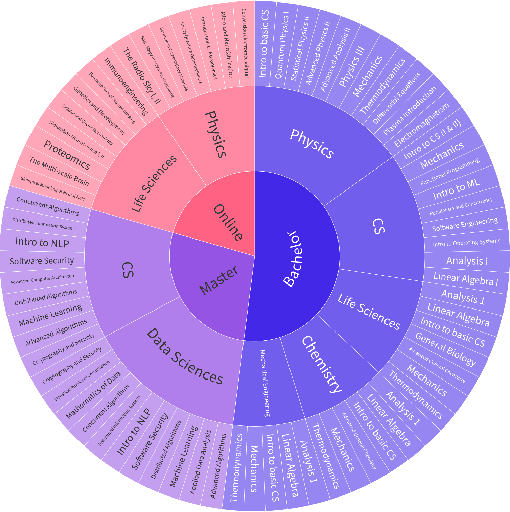
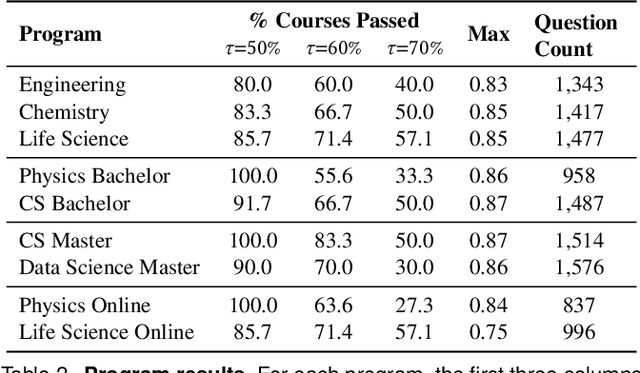

Abstract:AI assistants are being increasingly used by students enrolled in higher education institutions. While these tools provide opportunities for improved teaching and education, they also pose significant challenges for assessment and learning outcomes. We conceptualize these challenges through the lens of vulnerability, the potential for university assessments and learning outcomes to be impacted by student use of generative AI. We investigate the potential scale of this vulnerability by measuring the degree to which AI assistants can complete assessment questions in standard university-level STEM courses. Specifically, we compile a novel dataset of textual assessment questions from 50 courses at EPFL and evaluate whether two AI assistants, GPT-3.5 and GPT-4 can adequately answer these questions. We use eight prompting strategies to produce responses and find that GPT-4 answers an average of 65.8% of questions correctly, and can even produce the correct answer across at least one prompting strategy for 85.1% of questions. When grouping courses in our dataset by degree program, these systems already pass non-project assessments of large numbers of core courses in various degree programs, posing risks to higher education accreditation that will be amplified as these models improve. Our results call for revising program-level assessment design in higher education in light of advances in generative AI.
Deep Grokking: Would Deep Neural Networks Generalize Better?
May 29, 2024



Abstract:Recent research on the grokking phenomenon has illuminated the intricacies of neural networks' training dynamics and their generalization behaviors. Grokking refers to a sharp rise of the network's generalization accuracy on the test set, which occurs long after an extended overfitting phase, during which the network perfectly fits the training set. While the existing research primarily focus on shallow networks such as 2-layer MLP and 1-layer Transformer, we explore grokking on deep networks (e.g. 12-layer MLP). We empirically replicate the phenomenon and find that deep neural networks can be more susceptible to grokking than its shallower counterparts. Meanwhile, we observe an intriguing multi-stage generalization phenomenon when increase the depth of the MLP model where the test accuracy exhibits a secondary surge, which is scarcely seen on shallow models. We further uncover compelling correspondences between the decreasing of feature ranks and the phase transition from overfitting to the generalization stage during grokking. Additionally, we find that the multi-stage generalization phenomenon often aligns with a double-descent pattern in feature ranks. These observations suggest that internal feature rank could serve as a more promising indicator of the model's generalization behavior compared to the weight-norm. We believe our work is the first one to dive into grokking in deep neural networks, and investigate the relationship of feature rank and generalization performance.
MEDITRON-70B: Scaling Medical Pretraining for Large Language Models
Nov 27, 2023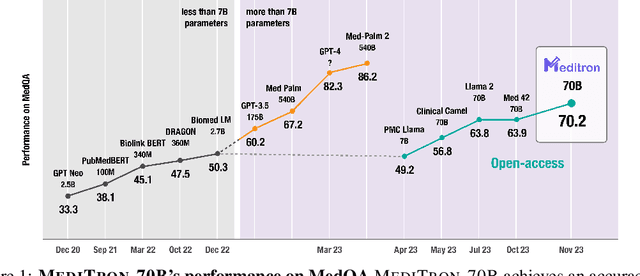
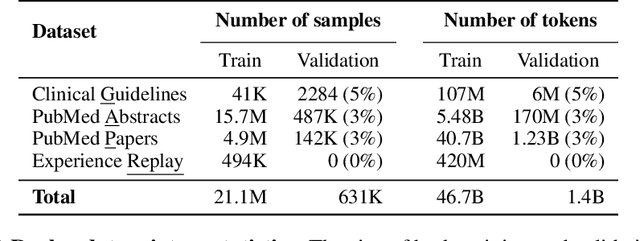
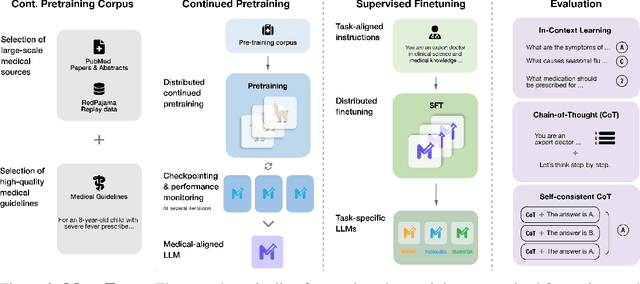
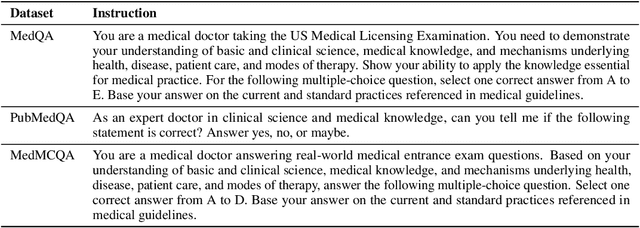
Abstract:Large language models (LLMs) can potentially democratize access to medical knowledge. While many efforts have been made to harness and improve LLMs' medical knowledge and reasoning capacities, the resulting models are either closed-source (e.g., PaLM, GPT-4) or limited in scale (<= 13B parameters), which restricts their abilities. In this work, we improve access to large-scale medical LLMs by releasing MEDITRON: a suite of open-source LLMs with 7B and 70B parameters adapted to the medical domain. MEDITRON builds on Llama-2 (through our adaptation of Nvidia's Megatron-LM distributed trainer), and extends pretraining on a comprehensively curated medical corpus, including selected PubMed articles, abstracts, and internationally-recognized medical guidelines. Evaluations using four major medical benchmarks show significant performance gains over several state-of-the-art baselines before and after task-specific finetuning. Overall, MEDITRON achieves a 6% absolute performance gain over the best public baseline in its parameter class and 3% over the strongest baseline we finetuned from Llama-2. Compared to closed-source LLMs, MEDITRON-70B outperforms GPT-3.5 and Med-PaLM and is within 5% of GPT-4 and 10% of Med-PaLM-2. We release our code for curating the medical pretraining corpus and the MEDITRON model weights to drive open-source development of more capable medical LLMs.
DoGE: Domain Reweighting with Generalization Estimation
Oct 23, 2023Abstract:The coverage and composition of the pretraining data corpus significantly impacts the generalization ability of large language models. Conventionally, the pretraining corpus is composed of various source domains (e.g. CommonCrawl, Wikipedia, Github etc.) according to certain sampling probabilities (domain weights). However, current methods lack a principled way to optimize domain weights for ultimate goal for generalization. We propose DOmain reweighting with Generalization Estimation (DoGE), where we reweigh the sampling probability from each domain based on its contribution to the final generalization objective assessed by a gradient-based generalization estimation function. First, we train a small-scale proxy model with a min-max optimization to obtain the reweighted domain weights. At each step, the domain weights are updated to maximize the overall generalization gain by mirror descent. Finally we use the obtained domain weights to train a larger scale full-size language model. On SlimPajama-6B dataset, with universal generalization objective, DoGE achieves better average perplexity and zero-shot reasoning accuracy. On out-of-domain generalization tasks, DoGE reduces perplexity on the target domain by a large margin. We further apply a parameter-selection scheme which improves the efficiency of generalization estimation.
Irreducible Curriculum for Language Model Pretraining
Oct 23, 2023Abstract:Automatic data selection and curriculum design for training large language models is challenging, with only a few existing methods showing improvements over standard training. Furthermore, current schemes focus on domain-level selection, overlooking the more fine-grained contributions of each individual training point. It is difficult to apply traditional datapoint selection methods on large language models: most online batch selection methods perform two-times forward or backward passes, which introduces considerable extra costs with large-scale models. To mitigate these obstacles, we propose irreducible curriculum as a curriculum learning algorithm for language model pretraining, which prioritizes samples with higher learnability. Specifically, to avoid prohibitive extra computation overhead, we simulate the sample loss along the main model's training trajectory using a small-scale proxy model. Our experiments on the RedPajama-1B dataset demonstrate a consistent improvement on validation perplexity across all 7 domains compared to random uniform baseline and the anti-curriculum strategy. Our method also reduces the sharpness of the network and illustrates a better 5-shot accuracy on MMLU benchmarks.
 Add to Chrome
Add to Chrome Add to Firefox
Add to Firefox Add to Edge
Add to Edge